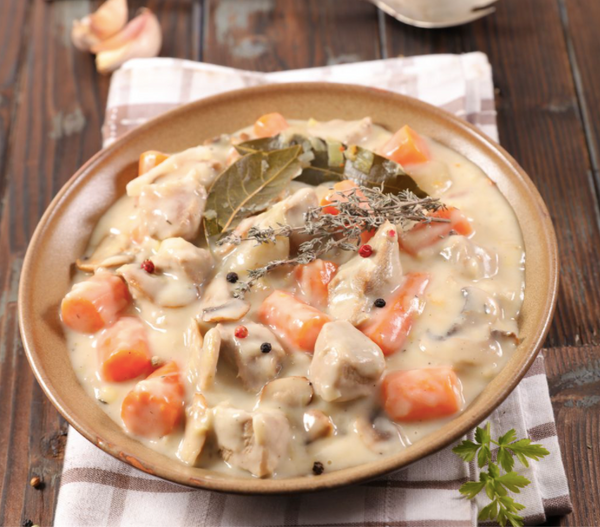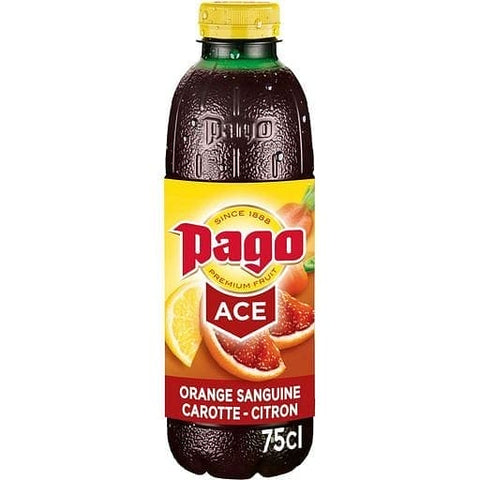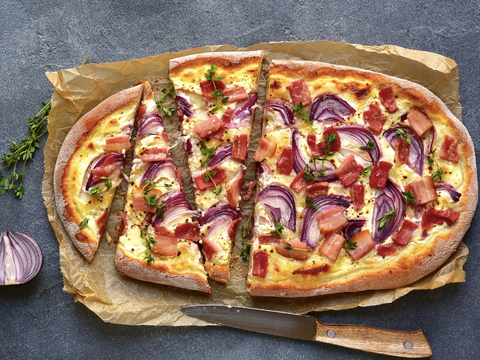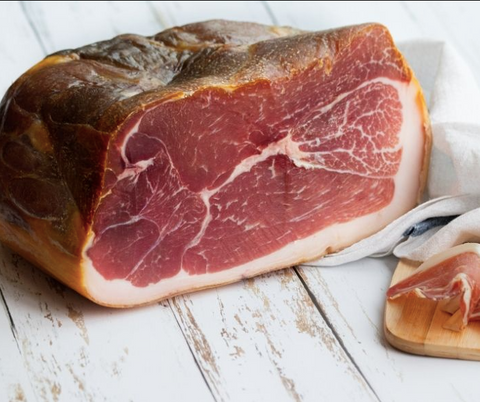What is La Blanquette de veau?
La Blanquette de veau is a classic French dish that is a kind of stew, but the cooking process is different from a typical stew.
In a typical stew, the meat, vegetables, and liquid are cooked together. In a Blanquette, the meat and vegetables are cooked separately from the juice and then combined during cooking. This gives the dish its unique, smooth texture.
The name "Blanquette" comes from the French word for white (Blanc), which refers to the color of this dish when it's done. The term "de veau" means "of veal." So you can translate la Blanquette de veau as "white veal stew".
- La Blanquette de veau is made with a tender young baby cow (veal) meat and mushrooms. It's traditionally served over white rice or egg noodles.
- A Blanquette is not difficult to make, but it involves several separate steps that take time and care. Let us walk you through each step so you can create your delicious version of this classic French dish!
Preparations for Blanquette de Veau
La Blanquette de veau is a French stew prepared with veal, mushrooms, onions, and carrots. It is a slow-cooked stew (Blanquette means "little white one" in French) served with white rice or egg noodles.
The dish had its roots in the middle Ages when it was prepared as an expensive meal for royalty. Commoners ate the word later on when it became more affordable. It is also similar to dishes from other cultures, like Italian ossobuco and American pot roast.
- The dish is traditionally made using cut-up chunks of meat cooked in broth. To prevent overcooking, the meat pieces are removed from the heat before the vegetables and returned before serving.
- A roux can be used as a thickener for the final product as you can help from here, but many cooks prefer cornstarch or flour mixed with egg yolks to create a smoother consistency. This method makes the classic "little white" stew for which the dish is named.
Defining characteristics of a Blanquette
So, what are the defining characteristics of a Blanquette?
The most important features of a Blanquette are:
- Meat: The meat used in a Blanquette is generally stewing cuts such as neck or shoulder. These cuts have more fat and collagen than leaner cuts like round or sirloin, making them ideal for stewing. However, they have to be browned to develop flavor before cooking in the liquid.
- A cooking liquid with no color: The liquid for a Blanquette is usually water or white wine, but some recipes call for broth made from veal bones. The fluid should not be colored; it's there simply to provide moisture and flavor to the meat.
- Thickener: The thickening agent for a Blanquette is typically flour that has been mixed with egg yolks and heavy cream to form a liaison. The liaison is whisked into the hot liquid at the end of cooking and allowed to thicken it into a creamy sauce.
- Vegetables: Blanquettes typically use white-colored vegetables, such as onion and leek, which do not color the sauce too much. Vegetables are sometimes removed before serving, but this is optional; you can leave them in if you like them.
There are a few other types of stew, but I think the defining characteristics are:
- According to cooking nytimes a Blanquette is a stew made with light meat (usually chicken or veal), and it has a creamy sauce.
- It's not browned first, so it does not have the flavor that you get from browning meat. This makes it delicate - it doesn't have a strong meaty flavor, but it also makes it very easy to cook. It's a basic technique that beginners can use without fear of ruining something by overcooking or otherwise messing up.
- It has mushrooms in it, and green peas sometimes too.
Origin of Blanquette de veau
Blanquette de veau is a French dish that features veal. It is cooked in a white sauce and is often served with rice.
In the past, Blanquette was a way to salvage meat that was not cooked properly. The cooking process for Blanquette is very gentle, and the meat is not seared at all. As a result, it remains white throughout cooking.
Blanquette can be considered a type of ragout or stew. It may be served as an appetizer or a main course.

Types of meat used in a Blanquette de veau
- A Blanquette de veau is typically made with veal. Veal is the meat of calves, in contrast to the beef from older cattle. The meat is very tender and pale in color. In France, where a Blanquette de veau originated, only the shoulder and breast are used for this dish. Other parts of the world may use stewing meat or even chicken for a Blanquette de veau.
- The term Blanquette refers to the white color of the dish and comes from the French word for "blanket," Blanc. A Blanquette is traditionally a stew made with veal or lamb, though chicken, rabbit, and even fish can also be used. While a stew is typically caused by browning the meat first, a Blanquette is not. Instead, the meat is cooked in liquid and then served surrounded by that same liquid. A traditional French Blanquette de veau includes pearl onions and mushrooms, but this recipe goes for simplicity, using only carrots.
Wines which goes with Blanquette de veau
It's not often you see a Blanquette de veau in the meat case, but when you do, you've got a great opportunity for a special meal. Blanquette de veau is stewed veal in a silky cream sauce. It's a classic French dish and great comfort food.
But what wine goes with Blanquette de veau?
The sauce has lemon, so look for wines with citrus characteristics. For example, a good Riesling or Gewurztraminer would be perfect because they typically have citrus flavors and classic floral aromas that go beautifully with white meats like veal.
- You can drink any dry white or pink wine with this traditional dish from the Alsace region of France.
- A dry Muscadet or another dry Loire Valley white is an excellent choice. Next, try a Sauvignon Blanc from Sancerre or Pouilly-Fumé for a richly textured and almost smoky match. Or try a dry Riesling from Alsace or Germany.
- For a pink match, try Pinot Gris from Alsace or Italy. Or try a rose from Provence or the Languedoc.
Which part of veal is Blanquette?
The Blanquette of veal is a specialty of French cuisine. The white part of the meat, shoulder or breast, is cooked with butter and onions, and then stewed in white sauce sprinkled with parsley.
Blanquette is a very old specialty from France that has undergone numerous variations. Blanquette was originally made with veal (piglet), lamb, chicken, or fish. It became more specific to the meat of the piglet in the 19th century.
- The Blanquette of veal is made from the fillets (the lean part) of the veal. It is usually served with a cream sauce and mushrooms but can also be filled with vegetables or fish.
- The veal is marinated for 24 hours in wine, and then cooked with mushrooms and aromatics.
- A Blanquette de veau is a French stew made from veal meat and mushrooms, braised in an aromatic sauce of butter, onions, carrots, thyme, and bay leaf. The meat and vegetables are cooked slowly in water until tender, and then finished in a creamy white sauce flavored with lemon juice.
In France, it is often served as a dish for formal dinners. It's not difficult to make, but it takes time to prepare like most stews or braises.
Taste of Blanquette de veau
Blanquette de veau (veal Blanquette) is a French stew traditionally made with white button mushrooms. It has a delicate flavor and is thickened or set with egg yolks, which differs from other stews thickened with flour or other starches. The dish is usually served with buttered noodles.
- The flavor profile of this dish comes from the combination of stock, white wine, and herbs. The veal itself has a more delicate flavor than beef and pork.
- The taste of veal can be very mild, and some find it slightly sweet.
- Veal is an excellent source of protein, iron, and B vitamins, so it is a great choice for those looking for healthier meals.
- This Blanquette de veau recipe with mushrooms includes carrots which provide fiber, beta-carotene, vitamin C, and potassium.
Reheating Blanquette de veau
You can safely reheat it, but you need to be very careful with the temperature.
- The reason for this is that Blanquette de veau contains milk. Milk is safe to eat when it's cold but becomes dangerous once it gets hotter than 60°C (140°F).
- Fortunately, most blanquettes de veau contain a roux that thickens the sauce and keeps it from splattering too much. This should prevent the milk from overheating and becoming toxic. If you cooked your Blanquette yourself, you might want to add a bit of roux before reheating it.
You can reheat your food using any method as long as you make sure that no part of the food stays above 60°C (140°F) for more than 30 minutes at a time. The best way to do this is by bringing your milk-based dish to a boil and then turning off the heat immediately. Stirring frequently will also help keep the temperature even throughout the world.
What means veal meat?
Veal is the meat of calves, in contrast to the beef from older cattle. However, most veal comes from young males of dairy breeds which are not used for breeding. Generally, veal is more expensive than beef from older cattle.
Some aspects of veal production are controversial due to animal welfare concerns. There are several types of veal:
- Bob veal: Calves raised for this meat are only a few days old (1–2 weeks) when slaughtered. It is so young that it has very little muscle tissue, which makes it pale and soft; it also has a large proportion of body fat, a higher proportion than even some adult cattle breeds have. This type of veal results in a lump of extremely tender meat, and because it is little or no marbling, it requires careful cooking to ensure that it does not become tough or dry during cooking (see below). It is more expensive than other types of veal.
- Rose veal: Calves raised for this meat are up to eight weeks old. The meat has slightly more flavor, owing to the increased level of myoglobin present in the muscle tissue; its color is darker than that of bob-veal.
Sauces for Blanquette de Van
There are three basic ways to make a sauce: butter, cream, or stock.
- The first two are classic methods that require a good deal of work — and you can't skimp on the butter if you want the sauce to be smooth. So there's less work for people who want to get an authentic taste of a particular dish.
- The third method, Blanquette purée, is just as easy to make but has the advantage of not requiring any heavy-duty kitchen equipment or ingredients. As a result, it's especially useful for beginners and those who don't have much time on their hands.
Here are some tips for making Blanquette de veau:
- Blanquette de veau is traditionally made with veal or chicken (or both), but it works well with beef or pork.
- You can substitute veal for beef or pork in this recipe by using leaner cuts. For example, if you're using chicken thighs instead of breast meat, cut them into small pieces and brown them in a skillet first; they'll take longer to cook than breast meat and need longer in the oven.
- You don't have to start with the raw vegetables called for in this recipe; use whatever vegetables you have on hand. I recommend using carrots as given in recipe of foodandwine .
So, throughout most of its history, Blanquette has been served as an appetizer or an entrée in fine dining establishments. Today, it may also be done in restaurants and family.




